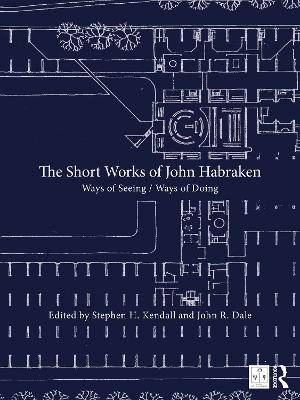
The Short Works of John Habraken
Routledge (Verlag)
978-0-367-82007-7 (ISBN)
This book offers, for the first time, access to the chronological arc of John Habraken’s writing in a single collection.
Few architects or scholars have so consistently and patiently pursued such a humane and culturally vital set of radical questions related to the behaviour of the built environment as N. John Habraken. From the publication of his first book in 1960, he has quietly helped redraw the map of architectural research, education, practice, design methods and theory. His insights lead us to a better understanding of how the built field works, contributing to the development of methods enabling professionals to contribute to its coherence and resilience.
Following an introductory essay by the editors, placing Habraken’s work in context, this collection is organized in two sections and further organized around a number of specific themes: The Built Field; Role of the Architect; Control; Sharing Forms; Examples of Ways of Doing; Open Building; Tools; and Cultivating the Built Environment. A series of interviews with the author enable him to reflect on his journey of inquiry, research, advocacy and teaching – and the relationship between ways of seeing and ways of doing.
Offering theoretical perspectives and methodological ways forward, this book will be of interest to architects, planners and urban designers tackling the challenges of the contemporary built environment that Habraken identifies, as well as educators and students.
Stephen H. Kendall, PhD, is Emeritus Professor of Architecture at Ball State University and co-founder and vice president of the Council on Open Building. He received his PhD under the direction of John Habraken at MIT. Dr. Kendall’s career in architectural practice, research and education spans more than 45 years. His teaching, writing and research focus on the Open Building approach needed to make buildings more adaptable, easier to customize to meet changing preferences and thus more sustainable. His work recognizes the increasing size and complexity of projects and the dynamics of living environments, the workplace and the marketplace where design must go beyond short-term uses and where control is distributed not only during initial planning but also over time. His most recent edited books include Healthcare Architecture as Infrastructure: Open Building in Practice (2019) and Residential Architecture as Infrastructure: Open Building in Practice (2022) both part of Routledge's Open Building Series. John R. Dale, FAIA, LEED AP, is a Principal and Pre-K-12 Studio Leader for HED. He received his SMarcS Post-professional degree in Architecture at MIT under the direction of John Habraken. He has been planning, programming and designing educational environments for over 25 years. In 2007, he was named a Fellow of the American Institute of Architects (AIA) for his achievements in school design. He creates high performance learning environments that are widely recognized models of regional and national significance. Mr. Dale also promotes green schools, building research that demonstrates that students are healthier and learn more effectively in sustainable, resilient environments. John’s projects have been honored with numerous awards at national, state and local levels, and he has taught at the University of Toronto, USC, MIT, UCLA, and California State Polytechnic University, Pomona. Mr. Dale is on the Board of the Architecture and Design Museum, Los Angeles and is Co-Founder and President of the Council on Open Building.
Part 1: Ways of Seeing Introduction to Ways of Seeing Beginning The Built Field Control Sharing Forms Role of the Architect Part 2: Ways of Doing Introduction to Ways of Doing Examples of Ways of Doing The Open Building Approach Tools Cultivating Built Environment Summing Up
| Erscheinungsdatum | 15.03.2023 |
|---|---|
| Reihe/Serie | Open Building |
| Zusatzinfo | 325 Halftones, black and white; 325 Illustrations, black and white |
| Verlagsort | London |
| Sprache | englisch |
| Maße | 178 x 254 mm |
| Gewicht | 1224 g |
| Themenwelt | Naturwissenschaften ► Biologie ► Ökologie / Naturschutz |
| Technik ► Architektur | |
| ISBN-10 | 0-367-82007-2 / 0367820072 |
| ISBN-13 | 978-0-367-82007-7 / 9780367820077 |
| Zustand | Neuware |
| Informationen gemäß Produktsicherheitsverordnung (GPSR) | |
| Haben Sie eine Frage zum Produkt? |
aus dem Bereich


